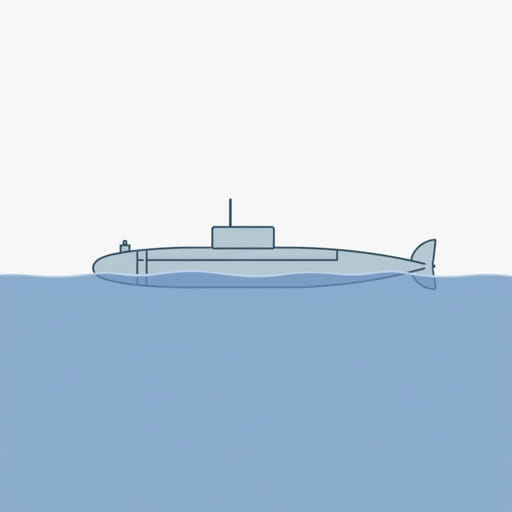During World War II, the Japanese submarine Ro-110 met its fate in a dramatic encounter with Allied naval forces. The sinking of Ro-110 marked another critical moment in the extensive and dangerous undersea warfare campaign that defined the Pacific and Indian Oceans. Ro-110 was part of the Imperial Japanese Navy’s effort to disrupt Allied supply lines and assert control over maritime zones. However, its mission came to an abrupt and fatal end, which symbolized the growing efficiency and dominance of the Allied anti-submarine warfare operations in 1944.
Background of the Japanese Submarine Ro-110
The Ro-110 belonged to the Ro-100 class of submarines in the Imperial Japanese Navy. These submarines were designed primarily for coastal operations, being smaller and more maneuverable than the larger I-class submarines. Commissioned in 1943, Ro-110 was relatively new to the war when she was sent on her final patrol. Her primary assignment was to operate in the Bay of Bengal, targeting Allied shipping routes that were crucial for transporting supplies and troops between India, Burma, and other parts of Southeast Asia.
Design and Capabilities
Ro-110 was built with the following specifications:
- Displacement: Around 601 tons (surfaced), 782 tons (submerged)
- Length: Approximately 60 meters
- Speed: 14 knots surfaced, 8 knots submerged
- Armament: Typically included four 53 cm torpedo tubes, a 76 mm deck gun, and a 13.2 mm anti-aircraft machine gun
The Ro-100 class submarines, including Ro-110, lacked the endurance and range of larger submarines, but their relatively compact design allowed for quicker construction and more rapid deployment across multiple fronts.
The Mission and Patrol
In early 1944, the Japanese Navy deployed Ro-110 to the Bay of Bengal, where she began operations against Allied shipping. The goal was to sink cargo ships and disrupt logistics operations crucial to British and Allied military movements in the region. During her final patrol, Ro-110 succeeded in sinking the British merchant vessel MV Asphalion, creating a temporary disruption. However, this success would soon be overshadowed by her own tragic end.
The Sinking of Ro-110
Ro-110’s destruction occurred on February 13, 1944, off the eastern coast of India near Visakhapatnam (then known as Waltair). Allied naval intelligence and codebreaking efforts had improved significantly by this point in the war, and submarine sightings were often followed up with aggressive and coordinated anti-submarine operations. Ro-110 was detected by the British convoy escort HMIS Jumna (a sloop of the Royal Indian Navy), along with support from the corvette HMIS Oudh and the British destroyer HMS Petard.
Engagement and Counterattack
After spotting a periscope or wake consistent with a submerged submarine, the escort vessels launched a determined depth charge attack. These depth charges were strategically dropped based on sonar readings, a tactic that had become increasingly effective against submarines. Ro-110 tried to evade the attackers, but her limited speed and depth capability made escape unlikely.
Several depth charges exploded near Ro-110, causing massive internal damage and eventually forcing the submarine to surface. Once she emerged, the escort ships opened fire with deck guns and attempted to ram her. Ro-110 sank shortly afterward, taking most, if not all, of her crew with her. Official records list her as lost with all hands.
Impact on the War Effort
The sinking of Ro-110 was a minor but symbolic victory for the Allied forces in the Indian Ocean theater. It demonstrated the increasing effectiveness of Allied anti-submarine warfare, especially the role played by the Royal Indian Navy, which was steadily growing in capability and responsibility. The loss of Ro-110 also meant one less threat to critical supply convoys moving between the Middle East, India, and Southeast Asia.
Allied Naval Superiority
By 1944, the Allies had gained a significant advantage in terms of radar, sonar, and code-breaking technologies. These advancements meant that submarines like Ro-110 could rarely operate undetected for long. Additionally, the coordination between aircraft, ships, and intelligence services made submarine operations increasingly hazardous for the Axis powers.
Japanese Submarine Strategy Failing
The Japanese naval strategy initially depended heavily on surface engagements and fleet-to-fleet battles. Submarines were not used as strategically or aggressively as those of the German Kriegsmarine. Over time, this contributed to their declining effectiveness. Losses such as that of Ro-110 further reduced their already-limited ability to influence the course of the war in distant theaters like the Indian Ocean.
Commemoration and Historical Significance
The story of Ro-110 is remembered today as part of the broader narrative of the undersea war in the Indian Ocean. While it may not be as widely recognized as battles in the Pacific or Atlantic, the submarine warfare campaign around India played a significant role in maintaining Allied momentum in Asia. The bravery of both the Ro-110 crew and the sailors aboard the Allied escort ships is acknowledged in various military archives and memorials.
Legacy of HMIS Jumna
HMIS Jumna, one of the key vessels involved in Ro-110’s sinking, earned considerable praise for her role. She was already a seasoned escort ship by this point, having seen extensive service escorting convoys and engaging enemy submarines. The successful defense of her convoy and the destruction of Ro-110 added to her distinguished war record.
The sinking of the Japanese submarine Ro-110 highlights a pivotal chapter in the naval history of World War II. Operating in the Bay of Bengal, Ro-110 was part of Japan’s attempt to strike at Allied logistics and maintain a presence far from its home waters. However, the increasingly sophisticated anti-submarine tactics used by the Allies, combined with technological superiority and relentless patrols, led to her demise in early 1944. Her destruction, carried out by Indian and British naval forces, was a testament to the global nature of the war and the essential role played by maritime security in the eventual Allied victory.
